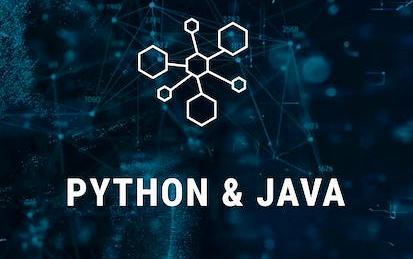

دوراتنا

Computational Thinking with Beginning C Programming
This specialization is designed to let you explore computational thinking and beginning C programming topics, applying those concepts to develop solutions to a variety of practical problems.The first course assumes no programming experience, and throughout the 4 courses in the specialization you'll learn about both computational thinking and C programming. The material in the courses in the specialization is equivalent to our computational thinking course at UCCS.
-
Course by

-
 Self Paced
Self Paced
-
 الإنجليزية
الإنجليزية

人群与网络
本课程是北京大学开设的一门在线跨学科选修课程,主要面向信息技术、社会学和经济学等专业的本科生。课程内容涉及用计算思维的方法讨论社会学和经济学的一些经典问题。学习运用计算思维分析社会学、经济学问题的方法,加深对某些生活现象的理解,体会计算与社会科学的互动。 Learn to analyze and reason about problems in social sciences with computational thinking, appreciate interactions between computing and social sciences, as well as gain deeper understanding of some common phenomena in life and society
-
Course by

-
 Self Paced
Self Paced
-
 صيني
صيني

Computational Thinking with JavaScript 3:Organise & Interact
This third course in the Computational Thinking with JavaScript specialization applies your developing JavaScript skills learned in the first two courses to the world of the web. You will learn how HTML and JavaScript together support the web pages with which we are so familiar, and develop skills so that you can create your own. As well as text presentation, at the heart of HTML, you will learn how to develop interactive, animated graphics, using JavaScript to dynamically add, remove and adjust the HTML objects on the screen.
-
Course by

-
 Self Paced
Self Paced
-
 29 ساعات
29 ساعات
-
 الإنجليزية
الإنجليزية

Computational Thinking for K-12 Educators: Sequences and Loops
How do we give instructions to a computer? Isn't programming hard? Not really! Whether it's giving someone directions to a nearby store or writing out some dance moves we frequently exhibit aspects of computational thinking in our everyday lives! This class teaches the first key concepts of programming -- sequences of instructions and basic counted repetition of instructions. For each concept, we'll start by helping you connect real-world experiences you are already familiar with to the programming concept you are about to learn.
-
Course by

-
 Self Paced
Self Paced
-
 11 ساعات
11 ساعات
-
 الإنجليزية
الإنجليزية

Computational Thinking with JavaScript 4: Create & Deploy
This is the fourth and final course in the Computational Thinking with JavaScript specialisation. It is an added-value unit and entirely builds on what you will have learned in the first three units and enables you to synthesise and develop that knowledge. The course supports you to develop your own larger application, using a combination of the technologies you have seen already, including HTML, JavaScript and various libraries, while also encouraging you to reach out to incorporate new libraries.
-
Course by

-
 Self Paced
Self Paced
-
 21 ساعات
21 ساعات
-
 الإنجليزية
الإنجليزية

Data Analysis and Representation, Selection and Iteration
This course is the second course in the specialization exploring both computational thinking and beginning C programming. Rather than trying to define computational thinking, we’ll just say it’s a problem-solving process that includes lots of different components. Most people have a better understanding of what beginning C programming means! This course assumes you have the prerequisite knowledge from the previous course in the specialization. You should make sure you have that knowledge, either by taking that previous course or from personal experience, before tackling this course.
-
Course by

-
 Self Paced
Self Paced
-
 11 ساعات
11 ساعات
-
 الإنجليزية
الإنجليزية

Simulation, Algorithm Analysis, and Pointers
This course is the fourth and final course in the specialization exploring both computational thinking and beginning C programming. Rather than trying to define computational thinking, we’ll just say it’s a problem-solving process that includes lots of different components. Most people have a better understanding of what beginning C programming means! This course assumes you have the prerequisite knowledge from the previous three courses in the specialization.
-
Course by

-
 Self Paced
Self Paced
-
 11 ساعات
11 ساعات
-
 الإنجليزية
الإنجليزية

Open Design
What is design? How is it a deeply human endeavor? How can we design better products, services, and experiences in our communities? If you’re interested in helping create a more equitable and accessible world, this Center for Computational Thinking module on Open Design is for you. In this introductory module to Open Design, you’ll learn how you can center equity in your design processes. You’ll learn how the iterative four mindsets of Open Design — understand, create, evaluate, and share — will guide you to meaningfully impact your community.
-
Course by

-
 Self Paced
Self Paced
-
 5 ساعات
5 ساعات
-
 الإنجليزية
الإنجليزية

Programming with Scratch
Learning coding is not only about understanding the programming language being used, but also developing important computational thinking skills, which are useful for problem solving across many disciplinary areas. In this course, students will learn basic programming skills by creating interactive storybooks, animations, and games with Scratch, which is a block-based visual programming language for anyone new to coding.
-
Course by

-
 Self Paced
Self Paced
-
 26 ساعات
26 ساعات
-
 الإنجليزية
الإنجليزية

Computational Thinking with JavaScript 2: Model & Analyse
This is the second course in a sequence of four courses that develops essential 21st century computational thinking (CT) skills using the popular JavaScript programming language. At the end of this second course you will: know a framework for CT to help you model the real world using abstract data structures; have developing CT skills so that you can perform comon data analytics tasks; be able to read and write programs in JavaScript that involve processing, analysing and visualizing data, using a specialised library; and post your creations on the web to share your code with others. This co
-
Course by

-
 Self Paced
Self Paced
-
 20 ساعات
20 ساعات
-
 الإنجليزية
الإنجليزية

Introduction to Programming with Python and Java
This Specialization starts out by teaching basic concepts in Python and ramps up to more complex subjects such as object-oriented programming and data structures in Java. By the time learners complete this series of four courses, they will be able to write fully-functional programs in both Python and Java, two of the most well-known and frequently used programming languages in the world today. Introduction to Programming with Python and Java is for students and professionals who have minimal or no prior programming exposure.
-
Course by

-
 Self Paced
Self Paced
-
 الإنجليزية
الإنجليزية

Programming for Data Science
Learn how to apply fundamental programming concepts, computational thinking and data analysis techniques to solve real-world data science problems.
-
Course by

-
 الإنجليزية
الإنجليزية

Abstraction, Problem Decomposition, and Functions
This course is the third course in the specialization exploring both computational thinking and beginning C programming. Rather than trying to define computational thinking, we’ll just say it’s a problem-solving process that includes lots of different components. Most people have a better understanding of what beginning C programming means! This course assumes you have the prerequisite knowledge from the previous two courses in the specialization. You should make sure you have that knowledge, either by taking those previous courses or from personal experience, before tackling this course.
-
Course by

-
 Self Paced
Self Paced
-
 17 ساعات
17 ساعات
-
 الإنجليزية
الإنجليزية

Computational Thinking & Block Programming in K-12 Education
In the 21st century, computational thinking is a skill critical for all the world's citizens. Computing and technology is impacting all our lives and everyone needs to know how to formulate problems and express their solutions such that a computer can carry it out. In this Specialization you will both learn several block-based languages, but using novel approaches designed to make learning programming easier. Covers most CSTA Algorithms & Programming Standards for Algorithms, Variables, Control, and Modularity: Levels 1-3A.
-
Course by

-
 Self Paced
Self Paced
-
 الإنجليزية
الإنجليزية

Teaching Computational Thinking
This course is for educators who are passionate about the future of their 7-12+ year old students and want to learn more about teaching computer science in an engaging and meaningful way.
-
Course by

-
 Self Paced
Self Paced
-
 15
15
-
 الإنجليزية
الإنجليزية

Data Structures Fundamentals
Learn about data structures that are used in computational thinking – both basic and advanced.
-
Course by

-
 الإنجليزية
الإنجليزية

Introduction to Computational Thinking and Data Science
6.00.2x is an introduction to using computation to understand real-world phenomena.
-
Course by

-
 Self Paced
Self Paced
-
 الإنجليزية
الإنجليزية

Algorithms, Data Collection, and Starting to Code
This course starts you on your journey learning about computational thinking and beginning C programming. If you’d like to explore how we can interact with the world in a rigorous, computational way, and would also like to start learning to program, this is the course for you! You may have heard lots of talk about computational thinking recently, but if you ask 10 different people what it is you’ll probably get 10 different answers. Rather than trying to define computational thinking, we’ll just say it’s a problem-solving process that includes lots of different components.
-
Course by

-
 Self Paced
Self Paced
-
 15 ساعات
15 ساعات
-
 الإنجليزية
الإنجليزية

Data-driven Astronomy
Science is undergoing a data explosion, and astronomy is leading the way. Modern telescopes produce terabytes of data per observation, and the simulations required to model our observable Universe push supercomputers to their limits. To analyse this data scientists need to be able to think computationally to solve problems. In this course you will investigate the challenges of working with large datasets: how to implement algorithms that work; how to use databases to manage your data; and how to learn from your data with machine learning tools.
-
Course by

-
 Self Paced
Self Paced
-
 24 ساعات
24 ساعات
-
 الإنجليزية
الإنجليزية
Computational Thinking for Problem Solving
Computational thinking is the process of approaching a problem in a systematic manner and creating and expressing a solution such that it can be carried out by a computer. But you don't need to be a computer scientist to think like a computer scientist! In fact, we encourage students from any field of study to take this course. Many quantitative and data-centric problems can be solved using computational thinking and an understanding of computational thinking will give you a foundation for solving problems that have real-world, social impact.
-
Course by

-
 Self Paced
Self Paced
-
 18 ساعات
18 ساعات
-
 الإنجليزية
الإنجليزية

Problem Solving Using Computational Thinking
Have you ever heard that computers "think"? Believe it or not, computers really do not think. Instead, they do exactly what we tell them to do. Programming is, "telling the computer what to do and how to do it." Before you can think about programming a computer, you need to work out exactly what it is you want to tell the computer to do. Thinking through problems this way is Computational Thinking. Computational Thinking allows us to take complex problems, understand what the problem is, and develop solutions.
-
Course by

-
 Self Paced
Self Paced
-
 11 ساعات
11 ساعات
-
 الإنجليزية
الإنجليزية
Computational Thinking with Javascript 1: Draw & Animate
This is the first course in a sequence of four courses that develops essential 21st century computational thinking (CT) skills using the popular JavaScript language as a vehicle. At the end of this first course you will: know a framework for CT to help you learn about it and work with others; be developing your CT skills so that you can more easily work with digital technology of all kinds; be able to read and write programs in JavaScript that involve drawing and animation, using a specialised library; and post your creations on the web so that others can appreciate your skills. This course
-
Course by

-
 Self Paced
Self Paced
-
 33 ساعات
33 ساعات
-
 الإنجليزية
الإنجليزية



